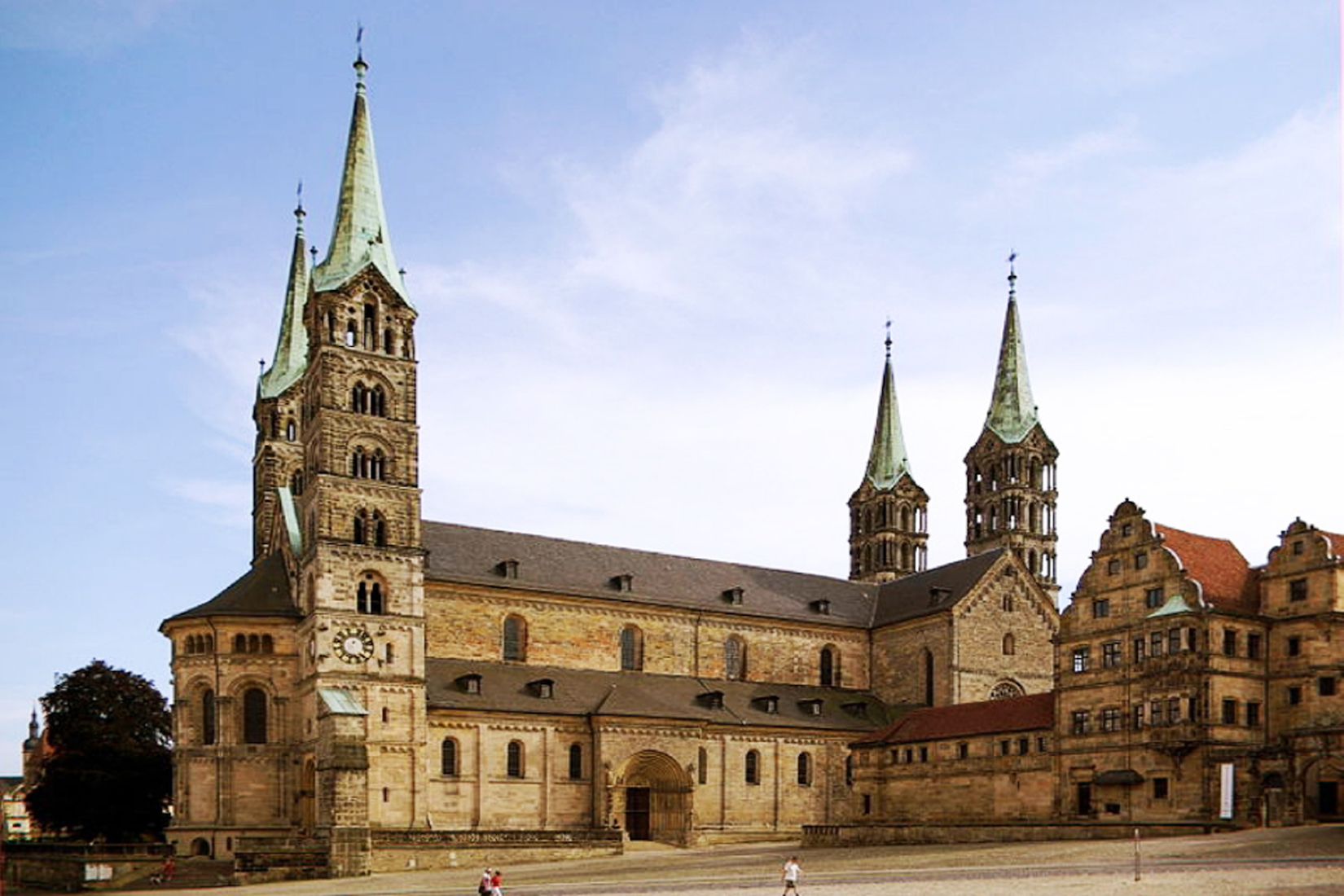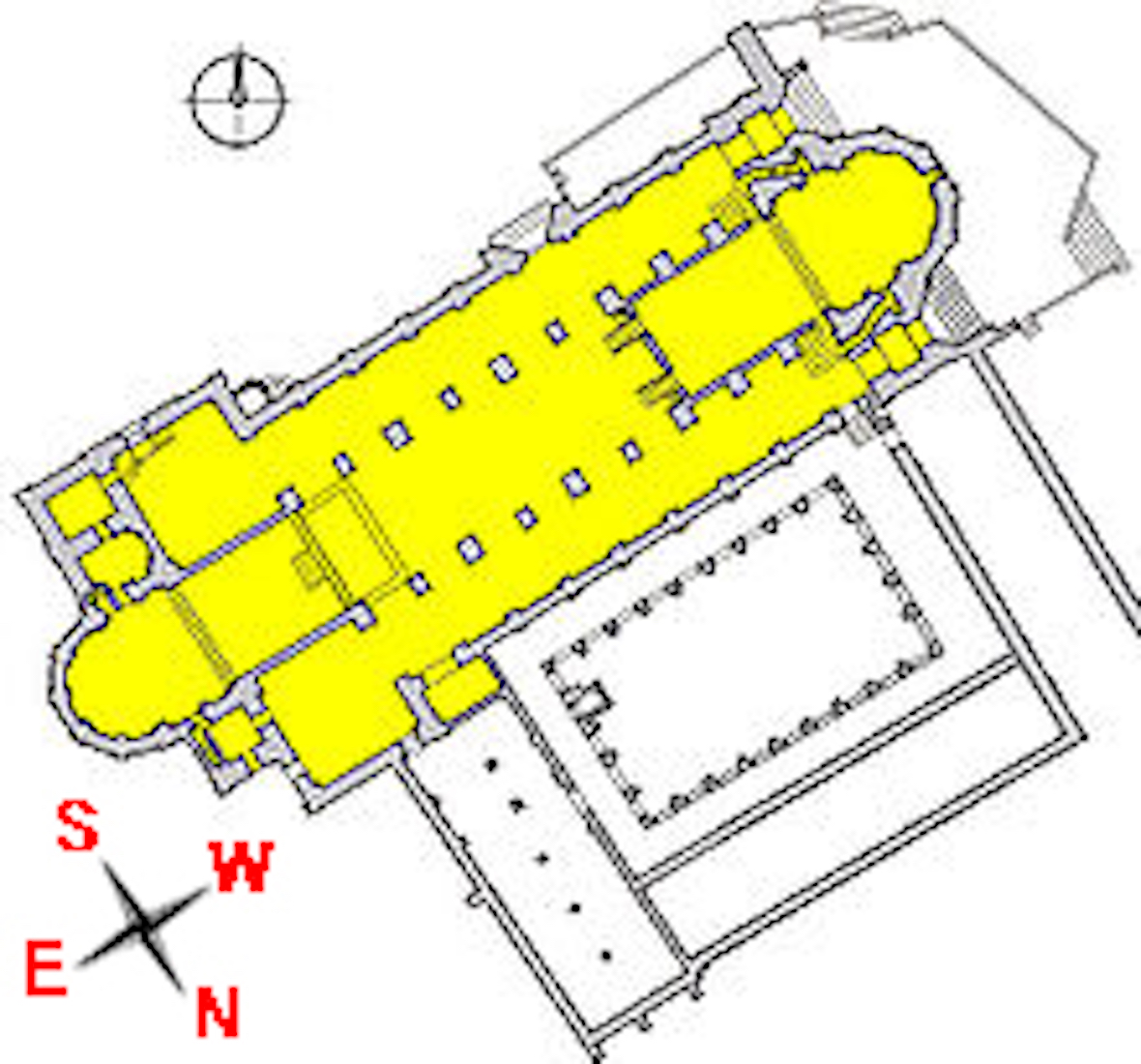CATHEDRAL OF ST PETER & ST GEORG
BAMBERG, GERMANY
PAUL SCOTT
The main difficulty with Bamberg Cathedral is its orientation! When viewed geographically, it sits as in this plan, with the direction ‘north’ straight up. As is our convention, we shall use Liturgical Directions, as indicated by the red compass points. Thus we shall enter through a door in the West wall (capital W) at top right. The West Choir (St Peter’s) is also at top right, and the East Choir (St Georg’s) is at bottom left. The yellow area indicates (roughly) the parts of the cathedral which have been photographed on this site.
A brief history of the Cathedral is given below. However, if you want to begin your tour of the Cathedral immediately, tap / click on START . You can also access intermediate points in the tour by a tap / click on the following links:
NOTE ON MAGNIFYING IMAGES
With this website format the images are large enough for most purposes. If there is a need for greater magnification of an image, go to the identical photo on
https://www.flickr.com/photos/paulscottinfo/albums
and use Command - + (Mac) or Windows - + (Windows).
HISTORY
[Wikipedia]
Bamberg Cathedral (German: Bamberger Dom, official name Bamberger Dom St. Peter und St. Georg) is a church in Bamberg, Germany, completed in the 13th century. The Cathedral is under the administration of the Roman Catholic Church and is the seat of the Archbishop of Bamberg. Since 1993, the Cathedral has been part of the UNESCO World Heritage Site ‘Town of Bamberg’.
It was founded in 1002 by King (and later Emperor) Heinrich II (Henry II) and consecrated in 1012. With the tombs of Henry II and his spouse Kunigunde, the Cathedral contains the remains of the only imperial couple that was canonized. With the tomb of Pope Clement II (1005 – 47) it also contains the only papal grave in Germany, and north of the Alps.
After the first two cathedrals burned down in the 11th and 12th centuries, the current structure, a late Romanesque building with four large towers, was built in the 13th century.
The Cathedral is about 94 m long, 28 m broad, 26 m high, and the four towers are each about 81 m high. It contains many works of art, including the marble tomb of the founder and his wife, the Empress Kunigunde, considered a masterpiece of the sculptor Tilman Riemenschneider, and carved between 1499 and 1513.
Another well-known treasure of the Cathedral is an equestrian statue known as the Bamberg Horseman (German: Der Bamberger Reiter). This statue, possibly depicting the Hungarian king Stephen I, most likely dates to the period from 1225 to 1237.
Background History
Heinrich (Henry), son of Heinrich der Zänker became Duke of Bavaria in 995, replacing his banished father. His favourite dwelling was at Bamberg and he gave that property (probably in spring 1000) to his wife Kunigunde as a wedding gift. In 1002, Heinrich was elected King of Germany and he started to conduct his government business from Bamberg, giving the town various privileges (mint, tolls, market rights). Probably late in 1002 the decision was made to establish a diocese at Bamberg. Henry was pious, he and his wife had no children to leave the property to and the eastern border of his kingdom still lacked a diocese. Against the opposition of the Bishop of Eichstätt, who lost the northern rim of his territory, and of the Bishop of Würzburg, who lost all of the eastern part of his, the Reichssynode of All Saints’ Day 1007 at Frankfurt established the Diocese of Bamberg. The Hochstift was endowed with royal territories, notably around Bamberg and near Villach. Kunigunde contributed Bamberg itself. The first bishop (1007 – 40) was Eberhard von Abenberg [de], Heinrich’s former chancellor. He took his home in the former Königspfalz. In 1007/1020 the diocese came under the direct authority of the Pope, and was thus henceforth outside of the control of the Archbishop of Mainz. King Heinrich (he was crowned Holy Roman Emperor only in 1014) became a canon of the cathedral chapter.
Construction history
Construction of this first Cathedral had begun in 1002, with work starting on two crypts. It was consecrated on Heinrich's birthday, on 6 May 1012. This first Cathedral was a cruciform basilica with the main choir in the west and a second to the east, each above a crypt. Two towers were located on the eastern façade. The nave was covered by a flat wooden ceiling. This Cathedral was smaller than the current structure (only around 75 m long). This Cathedral burned down in the Easter week of 1081. Whilst the interior art was completely destroyed, damage to the structure was relatively minor. It was quickly rebuilt – by 1087 it was possible to hold a synode here. Bishop Otto had the church rebuilt completely and it was reconsecrated in 1111.
This rebuilt church also burned down in 1185.
In 1047, the body of Pope Clement II (Bishop of Bamberg, 1040 – 6) was transferred from Rome to Bamberg and was buried in the Cathedral. With the destruction of the tomb of Pope Benedict V at Hamburg at the beginning of the 19th century, this became the only papal grave in Germany. All other popes are buried in France or Italy.
The current late Romanesque Cathedral was erected (with short intermissions) by three men of the house of Andechs-Merania: Otto [de] (bishop from 1177 – 96), Ekbert [de] (bishop 1203 – 37) and Poppo [de] (1237 – 42). The wealth of the Cathedral chapter and the generosity of the House of Andechs-Merania resulted in a large, splendid building. It was consecrated on 6 May 1237.
Later history
Heinrich had been canonized in 1146, as was Kunigunde in 1200. In 1499 – 1513, Tilman Riemenschneider created the tomb of the founders. Many other works of art were added during the Gothic period.
During the 17th century, the interior of the Cathedral was changed to Baroque style in two waves. The first came under Bishop Johann Gottfried von Aschhausen. The medieval coloured windows were removed. After 1626 the interior was whitened, painting over frescoes. A second wave followed after the end of the Thirty Years' War in 1648-53 under Bishop Melchior Otto Voit von Salzburg. The tomb of Heinrich and Kunigunde was moved, the rood screens were demolished and new high altars set up in both choirs.
In 1729 – 33, Balthasar Neumann, architect of the UNESCO World Heritage Site Würzburg Residence added the chapter house with administration offices for the Cathedral chapter.
In 1802/3, the Bishopric of Bamberg was secularised and became a part of the Electorate of Bavaria. In 1817, Bamberg became an archdiocese. The province includes the dioceses of Speyer, Würzburg and Eichstätt.
The Baroque alterations were removed in a ‘purification’ in 1828 – 37 ordered in 1826 by Ludwig I of Bavaria, who saw the Cathedral as a national monument. Altars and other sculptures were auctioned off in an attempt to return the church to its original, medieval state. Baroque art was replaced with Romanesque Revival art.
During a renovation of 1969 – 74, the church was changed in accordance with the Second Vatican Council, for example by moving the main altar from the eastern choir to a location in front of the western choir.




